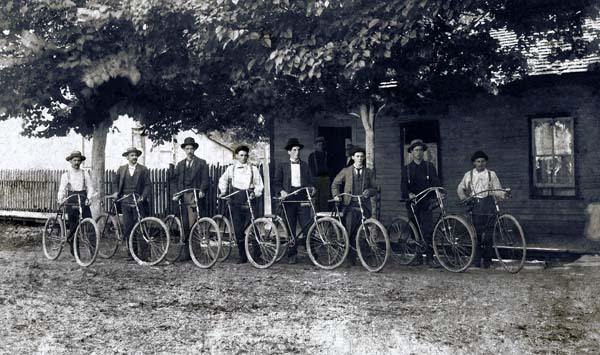Clay

Some of Clay's leading citizens posing with their fashionables bicycles on August 3, 1897. (Left to right) J.E. Springston,
Dr. L.B. Meadows, Dr. E.B. Stephenson, Patrick T. Board, S.R. Pierson, P.M. Summers, J.J. Saulsbury, and
W.C. Rogers. Courtesy of Kim Johnson.
On June 24, the Elk River at Clay crested at 30 feet—12 feet above flood stage—inundating the town and cutting off nearby communities, such as Bomont and Procius. It was the third-highest crest on record for the town of Clay, trailing only the 1918 flood, which topped out at 32 feet, and the New Year’s Day 1861 flood, which reached 31 feet. Although the Elk has overflowed its banks a number of times over the last two decades, it’s been by only a few feet, and most of the town was built high enough to avoid damage from seasonal damage.
Although the Clay County seat was established at Clay in 1858, it was a small farming village for most of the late 1800s. Clay’s birth as a town can be dated to December 10, 1895, when the first train on the Charleston, Clendenin, & Sutton Railroad arrived. Prior to that, Clay was largely inaccessible by anything other than water. In his memoirs, former Governor William MacCorkle notes that before the railroad, you had to travel on the Elk River to get to Charleston—even a horse-drawn carriage couldn’t make it.
In 1900, the Charleston, Clendenin, & Sutton was extended to Ivydale—about 12 miles north—and eventually on to Sutton and Elkins, as part of Henry G. Davis’ Cole & Coke Railway. The Buffalo & Gauley Railroad soon reached the nearby town of Dundon from Widen, which would become a coal-producing powerhouse.
Now connected to the outside world by rail, Clay took off as a legal, banking, and commercial center for the coal, timber, oil, and gas industries, which spread out from it like spokes. Hotels, grocery stores, clothing stores, bookstores, and five-and-dimes sprung up on the hills overlooking the Elk. The natural resources were so prevalent that builders even struck a natural gas well while drilling an artesian well for the new county courthouse in 1896.
The town of Clay was bustling until key natural resources in the region took a financial hit in the last half of the 20th century. Making matters worse, just as Clay was put on the map by transportation, it took a blow when Interstate 79 bypassed by the town in the 1970s. The downtown district managed to survive, though, including such longtime businesses as Pierson Lumber.
Any story about Clay County would be remiss without mentioning one of West Virginia’s greatest gifts to food heritage. In 1912, Anderson Mullins discovered a slightly different type of apple tree near Porter Creek in Clay County. That tree produced fruit for nearly 50 years and became the ancestor of every Golden Delicious apple grown ever since. Each fall since 1972, the town of Clay has celebrated its culinary gift to the world with the Clay County Golden Delicious Festival.
You can read the rest of this article in this issue of Goldenseal, available in bookstores, libraries or direct from Goldenseal.